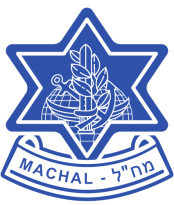Background Information on the British “White Paper”
During World War I, although technically citizens of the Ottoman Empire’s province of
Syria, Jews volunteered for service in the British Expeditionary Forces. First they joined Jabotinsky’s Zion Mule Corps, and later, together with Jewish volunteers from the U.S.A. and the U.K., formed the Jewish Legion, also known as the London Fusiliers, three battalions that participated in General Allenby’s final campaigns.
This alignment with the Allied cause in World War I, as well as the work of Dr. Chaim Weizmann and other outstanding Jewish leaders, led to the Balfour Declaration of November 1917, which declared Britain’s support for the establishment of a national home for the Jewish people in the now renamed Palestine, to be established without prejudicing the rights of the Arab inhabitants already living there. This declaration was enthusiastically supported by many British leaders, including Lloyd George, Winston Churchill, Arthur Balfour, and others.
Hussein Sharif, the leader of the Arab world during World War I, did not oppose the return of Jews to Palestine. His son, Feisal, who represented the Arab world at the Paris Peace Conference, wrote to Justice Felix Frankfurter of the United States: “There is room in Syria for us both. Indeed I think that neither can be a success without the other.”
During the war, promises of independence had been made to Arab leaders by the Allies, and these promises were later implemented in Syria, Lebanon and Iraq. But many Arabs were also to claim the area now known as Palestine to be within “Greater Syria”.
In 1922 the Council of the League of Nations granted a Mandate to the British Government, entrusting it inter alia with the task of ruling Palestine and implementing the Balfour Declaration. At the time approximately 85,000 Jews lived in Palestine. Included in this number were Jews who had lived for centuries in the country, and indeed for over a hundred years the Jewish population had constituted the majority of the citizens in the city of Jerusalem.
Under the Mandate, Jewish immigration, although limited by the authorities, increased the Jewish population seven-fold until by 1947 it numbered some 600,000. The higher standard of living created by the Jewish immigrants attracted Arabs from surrounding countries, and their population grew to over one million in the same period, as there were no limitations on their settling in Palestine.
The Palestine Mandate granted to Britain included the entire area of Trans-Jordan on the East Bank of the River Jordan, as well as the area on the West Bank. In 1922, the British Secretary of State for the colonies, Winston Churchill, created an emirate under Emir (later King) Abdullah in the area of Trans-Jordan, later to become an independent country, Jordan.
Thus, 80 percent of the mandated area of Palestine was allocated as an autonomous area for the Arabs of Palestine. But over the years – in 1922, 1929, and 1936 – Arab disturbances broke out incited by the Mufti of Jerusalem, Haj Amin el-Husseini. In 1937, a British Royal Commission headed by Lord Peel recommended the partition of Palestine into a Jewish State, a continued Mandate for Jerusalem, and the annexation of the remainder to Trans-Jordan. The Jewish community was willing to contemplate such a solution, but the Arabs were not.
In 1939 the British had promulgated a policy document called “The White Paper of 1939.” It imposed a quota for Jewish immigration and limited Jewish acquisition of land. The White Paper deplored both Arab terrorism and the unlimited Jewish immigration which inspired it.
The White Paper accordingly set the goal of bringing the Jewish population up to approximately one-third of the total population of the country, and allowed only an additional 75,000 immigrants, starting with 10,000 per year over the following five years. Keeping the Jews as a minority was specifically intended to appease Arab concerns by thwarting Jewish sovereignty in any democratic or representative government. The Zionists sought precisely the opposite.
Both sides hated the White Paper which was obviously pro-Arab. Violence against Jewish communities continued, and in addition, the British needed to secure Palestine as the strategic flank of its vital interest in Egypt, mainly the Suez Canal and access to the oil producing countries in the Middle East.
Background Information on Aliyah Bet
The Jewish Agency and the Haganah had already begun Aliyah Bet – illegal immigration – in a small way in the 1930s; in addition, some attempts to promote it were made during World War II, even though the British enforcement of their White Paper policy was successful.
In spite of this, over 30,000 of the Jewish population volunteered into the British forces, seeing service in North Africa, Italy and Europe. The war and the Holocaust wrought by Nazi Germany, resulted in the murder of six million Jews. The remnants who survived clamored to leave Europe and reach a national home in Palestine, but the British Government was committed to severely limiting Jewish immigration and the sale of land for Jewish settlements. Thus the new post-war British Labour government found itself on a collision course with the Jews of Palestine. This caused the Haganah and the Mossad to mount an aggressive policy of transporting displaced war refugees to Palestine.
Against this background, some 250 North American Jews, as well as some non-Jews, volunteered to serve on the Aliyah Bet ships bringing survivors of the Holocaust to Palestine. Most of them had completed between two to five years of service in World War II, but not many had served in the navy, and were therefore inexperienced seamen.
Link to the story of Aliyah Bet
The “Exodus 1947” (“President Warfield”)
With the increase of illegal immigration, the British authorities decided to stop it by a new plan: sending the ships back to their ports of embarkation. The first and only ship involving this new policy was the “Exodus.”
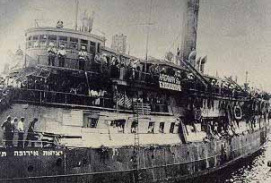
Formerly the “President Warfield,” and launched at Wilmington, Delaware, in 1928, it had sailed as a pleasure cruiser on the Chesapeake Bay between Norfolk, Virginia, and Baltimore for over a decade, with the exception of two seasons of sailing on the Long Island Sound from 1928 until 1942.
In 1942 it was appropriated by the United States Wartime Shipping Administration for convoy duty as the “U.S.S. President Warfield” (IX 169). In 1943 it was in a convoy attacked by German U-Boats and later deployed in the Normandy invasion as a barrack headquarters, coming under German air attacks.
Decommissioned in 1946, the ship was bought for US$8,000 as scrap by the Western Trading Company, a front for the Haganah, which later became the Israel Defense Forces. It is said that Jewish-American Sam (the Banana Man) Zemurray was instrumental in obtaining the ship for the Haganah, which would explain its Honduran registration as Zemurray United Fruit Company, a company which pretty much owned the banana republic of Honduras. The shallow draft of the Bay steamer seemed ideal for the Haganah tactic of beaching boats containing refugee immigrants off the shores of Palestine, then bringing the passengers in by lifeboat or by wading ashore.
The steamship was refitted in Baltimore and sailed from that port for France on 25th February 1947, carrying 4,554 Jewish men and women and 655 children, all survivors of the Holocaust, trailed by the “Ajax” and several destroyers.
The commander of the cruiser “Ajax” repeatedly demanded by loudspeakers that the ship discontinue its journey. However, Captain Ike Aronowicz ignored the demands and steered the President Warfield towards the Bat Yam beach in Palestine.
On 17th July 1947, the President Warfield was renamed “Exodus 1947” in a ceremony on the open sea, the Zionist blue-white flag with the Star of David was hoisted and “Hatikvah,” later to become the Israeli national anthem, was sung over and over.
The following night, two British destroyers rammed the “Exodus 1947” from both sides, damaging the hull, railings and lifeboats. It was boarded by sailors and Royal Marines and a desperate struggle developed, the refugees using tin cans, screwdrivers, potatoes, bottles, wooden boards and metal bars as weapons. As described by a refugee Noah Klieger, “we were determined not to surrender the ship to the British without a fight. It was an unequal battle, and eventually the Royal Navy boarding party, using truncheons and light firearms, succeeded in bringing the “Exodus” under its control. The clash had lasted several hours and resulted in three deaths –- Second Officer William (Bill) Bernstein, an American Aliyah Bet volunteer crew member, a 15-year-old refugee Zvi Jakubowitz, and one other. Some 150 were injured, including other American volunteer crew members.”
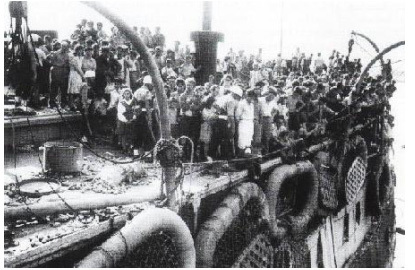
The “Exodus 1947” passengers were kept in check on deck with truncheons. Their “weapons” (potatoes) lie on the deck.
(United States Holocaust Memorial Museum, Washington D.C.).
In the late afternoon of 18th July 1947, the “Exodus 1947” was escorted to the port of Haifa by the British warships.
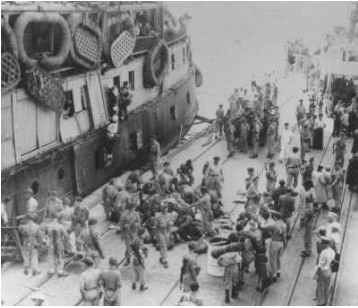
As UN official Emil Sandstroem (bottom right, white hat) looks on, British soldiers remove Jewish refugees from the ship “Exodus 1947.” The passengers are deported back to Europe. Haifa, Palestine, July 20 1947. ( Central Zionist Archives)
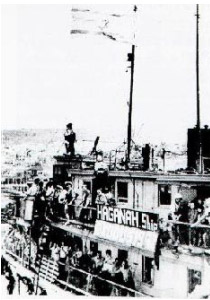
The “Exodus 1947,” flying the Zionist flag, being escorted by the British into Haifa.
(Stiftung Preußische Kulturbesitz, Berlin)
After reaching Haifa, British soldiers transferred the “Exodus 1947” passengers, exhausted from the sea journey and the battle, to three freighters converted into caged prison ships. It was named “Operation Oasis.”
The next day, the three caged prison ships, the “Ocean Vigour,” the “Runnymede Park,” and the “Empire Rival,” departed Haifa with the “Exodus” passengers. 1,464 people were accommodated on the “Ocean Vigour,” some 1,409 on the “Runnymede Park” and 1,526 were crammed into the belly of the “Empire Rival.”
The refugees assumed that as illegal emigrants they would be interned in camps on the island of Cyprus. But what was initially a rumor was later confirmed: the three prison ships were sailing towards the European mainland, back towards France. The conditions on board these ships were harsh. The refugees lay crammed together in the bare holds of the freighters.
Noah Klieger remembers his impressions of the “Empire Rival:”
“We slept, squeezed together, on the bare boards of the ship.”
Groups were formed on all three ships, and under Haganah command, they began to build an organization. It was resolved that all passengers were to remain on board, and not disembark, on arriving in France. The refugees were repeatedly encouraged to keep resisting. The success of these tactics was made more complicated as communication between the three ships was not possible.
The ships first landed at Toulon, France, where the passengers were ordered to disembark. When the French authorities refused to use force to remove the refugees from the ship, British authorities, fearing adverse public opinion, decided to wait until the passengers disembarked of their own accord. But the passengers, including many orphaned children, forced the issue by declaring a hunger strike, the British were forced to return them to Lübeck (near Hamburg), in the British-occupied zone of Germany. Amid worldwide public outrage, the British authorities compelled the passengers to disembark, and some were forcibly removed from the ship. The passengers were then transferred to displaced persons camps in Germany.
Though the mission was not successful in delivering any immigrants to Eretz Yisrael, it did attract international media attention, and persuaded the United Nations Special Committee on Palestine to recommend partitioning Palestine and establishing a Jewish state. The former passengers were permitted to immigrate to Palestine in small groups, and most were present in Israel on May 15 1948 when the nation declared its independence.
Link to British secret naval report on President Warfield
Link to Exodus 1947 film” – https://www.exodus1947.com/watch.html
The crew of the “Exodus 1947”
|
USA |
USA |
|
Aras, Joe |
Marks, Bernard |
|
Aranoff, Murray |
Miller (Milla), Bernard (Dov) |
|
Baruch, Kurt |
Millman, David |
|
Bernstein, William (Bill) |
Millman, William |
|
Baer (Belari), Shmuel |
Nadler, Nat |
|
Foreman, Bentley |
Naftali, Al |
|
Grauf, John (N/J) |
Rofe, Roger |
|
Goldstein, Myron |
Rosenfeld (Vardi), Teddy |
|
Kalmanowitz (Kalm), Eli |
Russel, Jack |
|
Kochavi (Storek), David |
Segal (Syval), Avraham |
|
Kolomeitzer (Cole), Arye |
Segal, Ze’ev (Vevie) |
|
Lavine, Frank |
Selove, Lou |
|
Leidner, Harold |
Sklar, Lenny |
|
Lester, Sol |
Stanczak, Frank |
|
Lipshitz (Livney), Arthur (Avi) |
Weinsaft, Harry |
|
Lowenthal, David |
Weinstein, Cyril (Cy) |
|
Malik, Louis |
Weiss, Mike |
|
Malovsky, Daniel |
|
|
UK |
MEXICO |
|
Cohen, Joshua, Dr. |
Margolis, Ruben |
|
Schulman, Samuel |
|
|
DENMARK |
|
|
Katzenelson, Zvi |
Source: Adapted and abridged by Joseph Wolf from the following sources:
i. USAHolocaustMemorialMuseum
ii. Jewish Virtual Library
iii. Everything2.com
iv. Introductory historical background from “The Arab Israeli Wars” by Chaim Herzog.
THE STORY OF THE SHIP “EXODUS 1947”
Background Information on the British “White Paper”
During World War I, although technically citizens of the Ottoman Empire’s province of
Syria, Jews volunteered for service in the British Expeditionary Forces. First they joined Jabotinsky’s Zion Mule Corps, and later, together with Jewish volunteers from the U.S.A. and the U.K., formed the Jewish Legion, also known as the London Fusiliers, three battalions that participated in General Allenby’s final campaigns.
This alignment with the Allied cause in World War I, as well as the work of Dr. Chaim Weizmann and other outstanding Jewish leaders, led to the Balfour Declaration of November 1917, which declared Britain’s support for the establishment of a national home for the Jewish people in the now renamed Palestine, to be established without prejudicing the rights of the Arab inhabitants already living there. This declaration was enthusiastically supported by many British leaders, including Lloyd George, Winston Churchill, Arthur Balfour, and others.
Hussein Sharif, the leader of the Arab world during World War I, did not oppose the return of Jews to Palestine. His son, Feisal, who represented the Arab world at the Paris Peace Conference, wrote to Justice Felix Frankfurter of the United States: “There is room in Syria for us both. Indeed I think that neither can be a success without the other.”
During the war, promises of independence had been made to Arab leaders by the Allies, and these promises were later implemented in Syria, Lebanon and Iraq. But many Arabs were also to claim the area now known as Palestine to be within “Greater Syria”.
In 1922 the Council of the League of Nations granted a Mandate to the British Government, entrusting it inter alia with the task of ruling Palestine and implementing the Balfour Declaration. At the time approximately 85,000 Jews lived in Palestine. Included in this number were Jews who had lived for centuries in the country, and indeed for over a hundred years the Jewish population had constituted the majority of the citizens in the city of Jerusalem.
Under the Mandate, Jewish immigration, although limited by the authorities, increased the Jewish population seven-fold until by 1947 it numbered some 600,000. The higher standard of living created by the Jewish immigrants attracted Arabs from surrounding countries, and their population grew to over one million in the same period, as there were no limitations on their settling in Palestine.
The Palestine Mandate granted to Britain included the entire area of Trans-Jordan on the East Bank of the River Jordan, as well as the area on the West Bank. In 1922, the British Secretary of State for the colonies, Winston Churchill, created an emirate under Emir (later King) Abdullah in the area of Trans-Jordan, later to become an independent country, Jordan.
Thus, 80 percent of the mandated area of Palestine was allocated as an autonomous area for the Arabs of Palestine. But over the years – in 1922, 1929, and 1936 – Arab disturbances broke out incited by the Mufti of Jerusalem, Haj Amin el-Husseini. In 1937, aBritish Royal Commission headed by Lord Peel recommended the partition of Palestine into a Jewish State, a continued Mandate for Jerusalem, and the annexation of the remainder to Trans-Jordan. The Jewish community was willing to contemplate such a solution, but the Arabs were not.
In 1939 the British had promulgated a policy document called “The White Paper of 1939.” It imposed a quota for Jewish immigration and limited Jewish acquisition of land. The White Paper deplored both Arab terrorism and the unlimited Jewish immigration which inspired it.
The White Paper accordingly set the goal of bringing the Jewish population up to approximately one-third of the total population of the country, and allowed only an additional 75,000 immigrants, starting with 10,000 per year over the following five years. Keeping the Jews as a minority was specifically intended to appease Arab concerns by thwarting Jewish sovereignty in any democratic or representative government. The Zionists sought precisely the opposite.
Both sides hated the White Paper which was obviously pro-Arab. Violence against Jewish communities continued, and in addition, the British needed to secure Palestine as the strategic flank of its vital interest in Egypt, mainly the Suez Canal and access to the oil producing countries in the Middle East.
Background Information on Aliyah Bet
The Jewish Agency and the Haganah had already begun Aliyah Bet – illegal immigration – in a small way in the 1930s; in addition, some attempts to promote it were made during World War II, even though the British enforcement of their White Paper policy was successful.
In spite of this, over 30,000 of the Jewish population volunteered into the British forces, seeing service in North Africa, Italy and Europe. The war and the Holocaust wrought by Nazi Germany, resulted in the murder of six million Jews. The remnants who survived clamored to leave Europe and reach a national home in Palestine, but the British Government was committed to severely limiting Jewish immigration and the sale of land for Jewish settlements. Thus the new post-war British Labour government found itself on a collision course with the Jews of Palestine. This caused the Haganah and the Mossad to mount an aggressive policy of transporting displaced war refugees to Palestine.
Against this background, some 250 North American Jews, as well as some non-Jews, volunteered to serve on the Aliyah Bet ships bringing survivors of the Holocaust to Palestine. Most of them had completed between two to five years of service in World War II, but not many had served in the navy, and were therefore inexperienced seamen.
Link to the story of Aliyah Bet
http://www.machal.org.il/index.php?option=com_content&view=article&id=370&Itemid=637&lang=en
The “Exodus 1947” (“President Warfield”)
With the increase of illegal immigration, the British authorities decided to stop it by a new plan: sending the ships back to their ports of embarkation. The first and only ship involving this new policy was the “Exodus.“

Formerly the “President Warfield,“ and launched at Wilmington, Delaware, in 1928, it had sailed as a pleasure cruiser on the Chesapeake Bay between Norfolk, Virginia, and Baltimore for over a decade, with the exception of two seasons of sailing on the Long Island Sound from 1928 until 1942.
In 1942 it was appropriated by the United States Wartime Shipping Administration for convoy duty as the “U.S.S. President Warfield“ (IX 169). In 1943 it was in a convoy attacked by German U-Boats and later deployed in the Normandy invasion as a barrack headquarters, coming under German air attacks.
Decommissioned in 1946, the ship was bought for US$8,000 as scrap by the Western Trading Company, a front for the Haganah, which later became the Israel Defense Forces. It is said that Jewish-American Sam (the Banana Man) Zemurray was instrumental in obtaining the ship for the Haganah, which would explain its Honduran registration as Zemurray United Fruit Company, a company which pretty much owned the banana republic of Honduras. The shallow draft of the Bay steamer seemed ideal for the Haganah tactic of beaching boats containing refugee immigrants off the shores of Palestine, then bringing the passengers in by lifeboat or by wading ashore.
The steamship was refitted in Baltimore and sailed from that port for France on 25th February 1947, carrying 4,554 Jewish men and women and 655 children, all survivors of the Holocaust, trailed by the “Ajax” and several destroyers.
Link to Alan Tyler story
The commander of the cruiser “Ajax” repeatedly demanded by loudspeakers that the ship discontinue its journey. However, Captain Ike Aronowicz ignored the demands and steered the President Warfield towards the Bat Yam beach in Palestine.
On 17th July 1947, the President Warfield was renamed “Exodus 1947” in a ceremony on the open sea, the Zionist blue-white flag with the Star of David was hoisted and “Hatikvah,” later to become the Israeli national anthem, was sung over and over.
The following night, two British destroyers rammed the “Exodus 1947” from both sides, damaging the hull, railings and lifeboats. It was boarded by sailors and Royal Marines and a desperate struggle developed, the refugees using tin cans, screwdrivers, potatoes, bottles, wooden boards and metal bars as weapons. As described by a refugee Noah Klieger, “we were determined not to surrender the ship to the British without a fight. It was an unequal battle, and eventually the Royal Navy boarding party, using truncheons and light firearms, succeeded in bringing the “Exodus” under its control. The clash had lasted several hours and resulted in three deaths –- Second Officer William (Bill) Bernstein, an American Aliyah Bet volunteer crew member, a 15-year-old refugee Zvi Jakubowitz, and one other. Some 150 were injured, including other American volunteer crew members.”

The “Exodus 1947” passengers were kept in check on deck with truncheons.
Their “weapons” (potatoes) lie on the deck.
(United States Holocaust Memorial Museum, WashingtonD.C.).
In the late afternoon of 18th July 1947, the “Exodus 1947″ was escorted to the port of Haifa by the British warships.
As UN official Emil Sandstroem (bottom right, white hat) looks on, British soldiers remove Jewish refugees from the ship “Exodus 1947.” The passengers are deported back to Europe. Haifa, Palestine, July 20 1947. ( Central Zionist Archives)

The “Exodus 1947,” flying the Zionist flag, being escorted by the British into Haifa.
(Stiftung Preußische Kulturbesitz, Berlin)
After reaching Haifa, British soldiers transferred the “Exodus 1947” passengers, exhausted from the sea journey and the battle, to three freighters converted into caged prison ships. It was named “Operation Oasis.”
The next day, the three caged prison ships, the “Ocean Vigour,” the “RunnymedePark,” and the “Empire Rival,” departed Haifa with the “Exodus” passengers. 1,464 people were accommodated on the “Ocean Vigour,” some 1,409 on the “RunnymedePark” and 1,526 were crammed into the belly of the “Empire Rival.”
The refugees assumed that as illegal emigrants they would be interned in camps on the island of Cyprus. But what was initially a rumor was later confirmed: the three prison ships were sailing towards the European mainland, back towards France. The conditions on board these ships were harsh. The refugees lay crammed together in the bare holds of the freighters.
Noah Klieger remembers his impressions of the “Empire Rival:”
“We slept, squeezed together, on the bare boards of the ship.”
Groups were formed on all three ships, and under Haganah command, they began to build an organization. It was resolved that all passengers were to remain on board, and not disembark, on arriving in France. The refugees were repeatedly encouraged to keep resisting. The success of these tactics was made more complicated as communication between the three ships was not possible.
The ships first landed at Toulon, France, where the passengers were ordered to disembark. When the French authorities refused to use force to remove the refugees from the ship, British authorities, fearing adverse public opinion, decided to wait until the passengers disembarked of their own accord. But the passengers, including many orphaned children, forced the issue by declaring a hunger strike, the British were forced to return them to Lübeck (near Hamburg), in the British-occupied zone of Germany. Amid worldwide public outrage, the British authorities compelled the passengers to disembark, and some were forcibly removed from the ship. The passengers were then transferred to displaced persons camps in Germany.
Though the mission was not successful in delivering any immigrants to Eretz Yisrael, it did attract international media attention, and persuaded the United Nations Special Committee on Palestine to recommend partitioning Palestine and establishing a Jewish state. The former passengers were permitted to immigrate to Palestine in small groups, and most were present in Israel on May 15 1948 when the nation declared its independence.
Link to British secret naval report on President Warfield:
http://www.machal.org.il/index.php?option=com_content&view=article&id=264&Itemid=469&lang=en
The crew of the “Exodus 1947”
|
USA |
USA |
|
Aras, Joe |
Marks, Bernard |
|
Aranoff, Murray |
Miller (Milla), Bernard (Dov) |
|
Baruch, Kurt |
Millman, David |
|
Bernstein, William (Bill) |
Millman, William |
|
Baer (Belari), Shmuel |
Nadler, Nat |
|
Foreman, Bentley |
Naftali, Al |
|
Grauf, John (N/J) |
Rofe, Roger |
|
Goldstein, Myron |
Rosenfeld (Vardi), Teddy |
|
Kalmanowitz (Kalm), Eli |
Russel, Jack |
|
Kochavi (Storek), David |
Shiller, Samuel |
|
Kolomeitzer (Cole), Arye |
Segal (Syval), Avraham |
|
Lavine, Frank |
Selove, Lou |
|
Leidner, Harold |
Sklar, Lenny |
|
Lester, Sol |
Stanczak, Frank |
|
Lipshitz (Livney), Arthur (Avi) |
Weinsaft, Harry |
|
Lowenthal, David |
Weinstein, Cyril (Cy) |
|
Malik, Louis |
Weiss, Mike |
|
Malovsky, Daniel |
|
|
UK |
MEXICO |
|
Cohen, Joshua, Dr. |
Margolis, Ruben |
|
Segal, Ze’ev (Vevie) |
|
|
DENMARK |
|
|
Katzenelson, Zvi |
Source: Adapted and abridged by Joseph Wolf from the following sources:
i. USAHolocaustMemorialMuseum
ii. Jewish Virtual Library
iii. Everything2.com
iv. Introductory historical background from “The Arab Israeli Wars” by Chaim Herzog.
